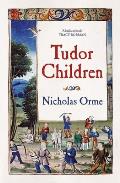 |
| Cover for Tudor Children by Nicholas Orme |
Medieval Children by Nicholas Orme is one of my favorite resource, so I was very excited to hear that he had a new book taking that research into the 16th century.
Like its predecessor, Tudor Children uses literary, documentary, and artistic sources to explore the lives and experiences of children in England during the Tudor Period (c.1485-1603). As Orme observes, few records made by children survive to reveal their lived experiences. Instead, small details must be drawn out of schoolbooks, memorial brasses, manuscript illuminations, popular plays, religious tracts, and occasionally court cases.
The eight chapters of this book (230 pages) are divided thematically into subjects such as religion, education, and recreation. The arrangement is also roughly chronological, beginning with birth/infancy, and ending with a chapter on adolescence. Although religion has its own chapter--dealing with baptism, religious instruction, and evidence for/against children's participation in church services--it also forms a frequent demarcation throughout the book. Every chapter includes some mention of the changes between pre-reformation and post-reformation England, whether in the ceremonies surrounding a birth, or in the reduced number of children's choirs in England after 1549.
A lot of the pre-1549 material is similar to Medieval Children, which makes sense, though it did give me a bit of deja vu. There is some very interesting historiographic discussion of how 16th century sources differ from earlier ones, including the effect of humanist education practices on surviving schoolboy writings. The book is also lavishly adorned with full-color images taken from contemporary art, such as that shown on the cover.
I do have one quibble with the research: on page 43-44, discussing children's clothing, the author states that drawers were worn, and elsewhere that their presence "can be assumed." This remark accompanies quotations listing the clothing provided for specific 16th century children, with drawers not included in the lists. I'm not sure where this came from; the main source cited for the topic of clothing, Anne Buck's Children's Costume in England, doesn't mention drawers before the late 17th century or braies after the 14th. It's a minor issue, but I don't like unsupported assertions of fact.
Despite that one point, I found this book enjoyable and informative, with sufficient citations and extensive quotations from period sources. The writing style is very readable by academic standards, though a step or two more formal than most popular history books.
Score: 5 stars.
Accuracy: High. Many period sources are quoted, and the book uses full academic citations with end notes. My one complaint in regards rigor is detailed above.
No comments:
Post a Comment
Thanks for commenting!